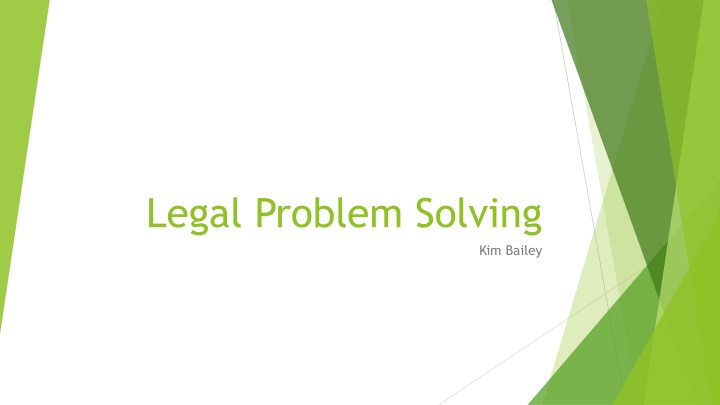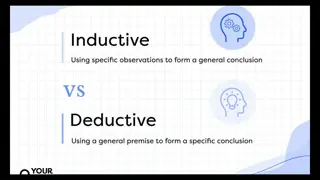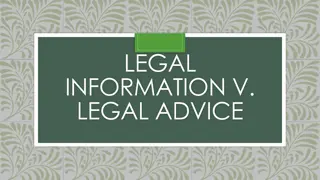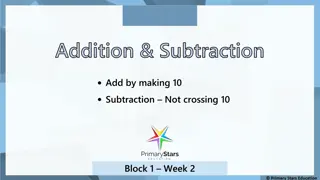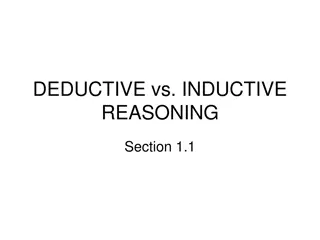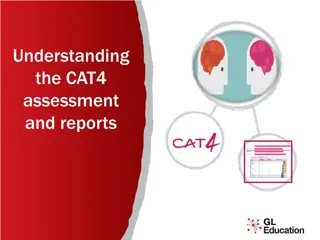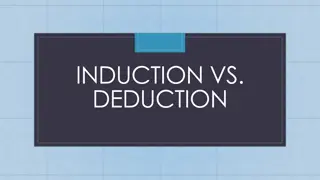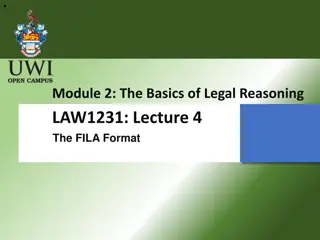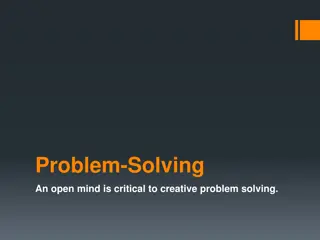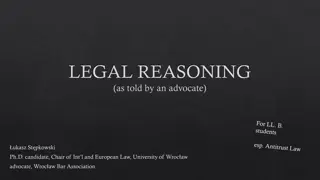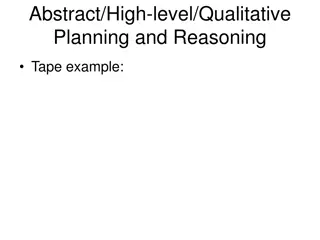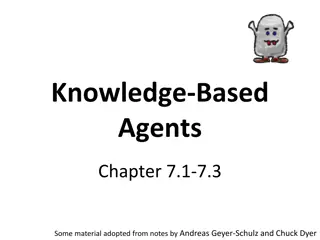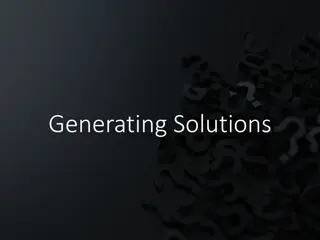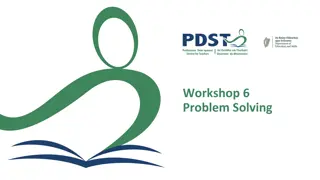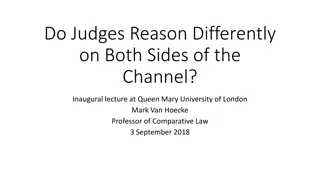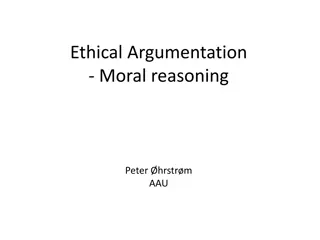Legal Problem Solving and Reasoning Methods
Learning legal problem-solving skills is essential for legal practice. The IRAC method, inductive and deductive reasoning play crucial roles in analyzing legal issues. Explore examples to understand how legal rules are applied in real-life scenarios.
Download Presentation

Please find below an Image/Link to download the presentation.
The content on the website is provided AS IS for your information and personal use only. It may not be sold, licensed, or shared on other websites without obtaining consent from the author.If you encounter any issues during the download, it is possible that the publisher has removed the file from their server.
You are allowed to download the files provided on this website for personal or commercial use, subject to the condition that they are used lawfully. All files are the property of their respective owners.
The content on the website is provided AS IS for your information and personal use only. It may not be sold, licensed, or shared on other websites without obtaining consent from the author.
E N D
Presentation Transcript
Legal Problem Solving Kim Bailey
Why learn Legal problem solving? Problem solving is a vital legal skill that you will require for legal practice It is a methodology that will enable you to work through new and unfamiliar situations to come to a reasoned conclusion You will use this skill to apply the knowledge you read in many of the Priestley 11 subjects IRAC translates directly into case analysis and legal drafting, especially memoranda and letters of advice
IRAC Method of Legal Problem Solving Identify the ISSUES the problem raises State these as questions Identify and state the relevant legal RULES that the legal problem area raises APPLY those rules to the specific facts of the case Come to a reasoned CONCLUSION of how the legal rules will apply/affect your particular problem-
Inductive and deductive reasoning Inductive reasoning is the creation or evolution of a rule. It is a generalised statement of what the law is. Deductive reasoning, in law, is the application of that rule to a particular fact or circumstance. It is how the law applies to any given problem. Deductive application of the law to the facts Inductive The legal rule or premise IRAC
Lets look at an example FACTS Chris and Bill are at the pub. They get into a heated argument over a football game that is airing on television. Chris starts yelling at Bill and deliberately tips his (Chris ) glass of beer over Bill s head. Chris is not intoxicated. Can Bill sue Chris in tort? INDUCTIVE PRINCIPLE THE LEGAL RULE To establish the tort of battery, the plaintiff must prove that the defendant has: a) committed a direct and intentional act b)that makes contact with the plaintiff s body, c) without the plaintiff s consent. DEDUCTIVE PRICIPLE APPLICATION OF THAT RULE Chris intended to upend the glass of beer over Bill. The beer made direct contact with Bill s body. Bill did not give consent to Chris to do this. This conduct constitutes the tort of battery.
Legal Problem Chris and Bill are at the pub. They get into a heated argument over a football game that is airing on television. Chris starts yelling at Bill. He says you better not leave this pub tonight, because I ll be waiting for you in the carpark . Chris slices his finger in a cutting motion across his throat. He then deliberately tips his (Chris ) glass of beer over Bill s head. Chris is not intoxicated. Can Bill sue Chris in tort?
Issues From Nichola Corbett-Jarivis and Brendan Grigg sEffective Legal Writing: A Practical Guide (Lexis Nexis 2014). What areas of law does the problem raise? 1 What issues do each area raise? (think what might a judge have to determine?) Procedure, duties, elements. Divide into issues and sub-issues. 2 What is the logical order to discuss this? Phrase issues as questions to be answered. 3 8
How to find the issues. Ask yourself: What facts are relevant in the scenario? Who are the parties? Where is the matter procedurally? Are there any key terms/definitions do you need to define?
Chris and Bill are at the pub. They get into a heated argument over a football game that is airing on television. Chris starts yelling at Bill. He says quietly you better not leave this pub tonight, because I ll be waiting for you in the carpark . Chris slices his finger in a cutting motion across his throat. Words a threat Threatening gesture Action pouring beer He then deliberately tips his (Chris ) glass of beer over Bill s head. Chris is not intoxicated. Can Bill sue Chris in tort?
Legal area of the Problem Do words that constitute a threat amount to a tort? Factual matter Relevant law (Rules) Assault Phrase as an issue 1. Has Chris committed the tort of assault? The words you better not leave the pub tonight because I will be waiting in the carpark Slicing gesture across his throat Do threatening gestures constitute a tort? Does tipping liquid over someone without hurting them constitute a tort? Assault 2. Has Chris committed the tort of assault? 3. Is tipping the beer a battery? The beer upended on Bill s head Battery
RULES Define the tort/crime/cause of action (secondary sources) Define Set out the elements of each tort (primary sources) Find elements Consider potential applicable defences (secondary and then primary) Consider defences
Assertions of law and fact An assertion of law requires a primary source authority (case or statute) An assertion of fact requires a secondary source Common knowledge or commonly understood legal principle requires no authority 1 1. See p94 P Baron and L Corbin s Legal Writing Academic and Professional Communication 2017 Oxford University Press
Assault: is an intentional1 offer of force or violence2 to the person of another, who reasonably believes3 that the threat will be carried out forthwith.4 The menace must be accompanied by an intention5 to raise in the mind of the person threatened an apprehension that violence is about to be committed.6 Thus, for instance, it is an assault to point a loaded gun at a person,7 whereas if the gun is not loaded, the tort is committed only if the plaintiff is unaware of that fact.8 Such actions may constitute an assault even though the defendant s threat of violence is conditional on the plaintiff doing or refraining from doing an act.9
Elements of assault: 1. A direct threat: Actual intent irrelevant (Rixon v Star City Pty Limited [2001] NSWCA 265). If defendant intend to use force or a gesture to create apprehension this establishes fault Hall v Foneca [1983] WAR309. Intent goes to creating apprehension. 2. Threat can be delivered by words or gestures or both (with words often interpreting gestures) Read v Coker (1853) 13 CB 850 A conditional threat of violence is still assault- Police v Greaves [1964] NZLR 295 Are these elements conjunctive ( and ), alternative ( or ) or aggregate (ie enough factors present = tort? 3. Plaintiff must apprehend harm (objective test reasonable apprehension) Expectation of actual physical interference. If defendant intentionally puts fear Macpherson v Beath 4. The threat must be imminent: imminent can be in a reasonable time in the future - Zanker v Vartzokas (1988) 34A Crim R. words alone not enough if threat not imminent: R v Knight (1988) 35A Crim R 314 If no ability to carry out threat, then no assault: Thomas v National Union of Mineworkers (South Wales) [1986] Ch20.Can include threats made by email and telephone if immediate physical harm threatened: Slevenski v State of Victoria [2010] VSC 441.
Rules Defences: Provocation: not a defence in NSW, only mitigates awards of exemplary damages Defence of self or others Consent
Battery is a direct and intentional (or negligent) act by the defendant that causes actual bodily contact with the plaintiff s body. To establish the tort of battery, the following elements are required: a) a direct and intentional act (note negligent acts can give rise to battery) Hutchins v Maughan [1947] VLR 131 b) that makes contact with the plaintiff s body Cole v Turner (1704) 6 Mod 149. Contact does not have to be offensive, or with the defendant s body. Contact by liquids is a battery: Pursell v Horn (1838) 112 ER 66, fingerprinting is battery, unauthorised surgery is battery: Malette v Shulman (1990) 67 DLR. c)without the plaintiff s consent or lawful authority
Rules Defences: Provocation: not a defence in NSW, only mitigates awards of exemplary damages Defence of self or others Consent
Application of the rules How do the legal rules apply to your facts? Can you distinguish the application because of the facts? Who is your client? Work both sides of the argument.
Synthesising rules and application of the rules From Nichola Corbett-Jarivis and Brendan Grigg sEffective Legal Writing: A Practical Guide (Lexis Nexis 2014) pp106-7. Three examples, which is best? 1. The first issue is whether the parties concluded a written agreement. Clearly, the parties did not conclude the contract because Jessica never returned the signed agreement to Roger. 2. The law requires that acceptance of an offer be communicated to the offeror. That obviously has not happened here. 3.The first issue is whether the parties concluded a written agreement. For an agreement to be concluded, the offeree must communicate acceptance of the offer to the offeror, as indicated in Felthouse v Bindley (1862) 142 ER 1037.As Jessica (offeree) did not return the written contract to Roger (offeror) or in any way indicate to him that she accepted the terms of the agreement, the contract was not concluded by way of written agreement. It is therefore necessary to consider whether the parties concluded an agreement by other means.
Application of the Rules If the rule is derived from one case, summarise the facts and cite If it derives from a number, reference these collectively Note how the facts of the authority are applicable or may be distinguished from your factual scenario For legislation, note correct Part, Chapter and section. Check that it has not been amended or repealed Research is a court has recently applied this rule, noting hierarchy and jurisdiction
In the present matter, Chris appears to have committed the torts of assault and battery against Bill. ASSAULT Chris direct threat, you better not leave this pub tonight, because I ll be waiting for you in the carpark on an objective test of the reasonable person, is adequate to constitute apprehension of imminent threat of bodily harm in Bill s mind. Zanker v Vartzokas (1988) 34A Crim R The threat is interpreted by the gesture of slicing the throat: Read v Coker (1853) 13 CB 850. More information would be required to consider provocation, however it would only mitigate against exemplary damages. BATTERY Chris act of tipping the beer is a direct act that makes bodily contact with the plaintiff s body There was no consent given It is actionable per se no harm required Contact by liquids may still amount to an assault: Pursell v Horn (1838) 112 ER 66
Conclusion Should always answer the questions you have raised in issues Should always explain why the interpretation of the legal rules you have made applies Should Explain why the facts of your case are distinguishable or applicable to authority Your conclusion should have summation, evaluation, prediction and recommendation. EG: Chris has committed the tort of assault and the tort of battery against Bill in the threat made not to leave the pub and the upending of beer. Whilst there is no defence available on the facts, more information would be required concerning the argument to determine if provocation could be raised to mitigate an award of exemplary damages. Bill would be entitled to nominal damages as well as the cost of dry cleaning his clothing. ALWAYS considers what the client s interests are and most expedient form of resolution. You may be legally right , but sometimes there is a better way to resolve disputes However, you can t resolve a dispute until you know the law MAKE A CALL. DON T EQUIVOCATE.
